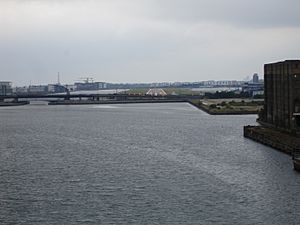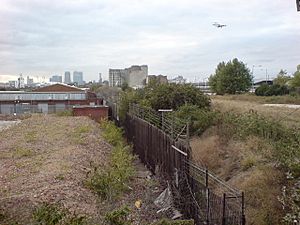Silvertown Quays facts for kids
Quick facts for kids Silvertown Quays |
|
|---|---|
 Looking East along the Royal Victoria Dock, towards London City Airport and the Royal Albert Dock. Silvertown Quays is the area to the right beyond the warehouse building |
|
| OS grid reference | TQ410801 |
| • Charing Cross | 6 mi (9.7 km) WSW |
| London borough | |
| Ceremonial county | Greater London |
| Region | |
| Country | England |
| Sovereign state | United Kingdom |
| Post town | LONDON |
| Postcode district | E20 |
| Dialling code | 020 |
| Police | Metropolitan |
| Fire | London |
| Ambulance | London |
| EU Parliament | London |
| UK Parliament |
|
| London Assembly | |
Silvertown Quays is a big project to rebuild an area in East London. It covers about 50 acres of land that used to be old warehouses in the Silvertown area. This spot is on the north side of the River Thames. It's also on the south side of the Royal Victoria Dock, right across from the ExCeL exhibition centre. It's also very close to London City Airport.
Contents
What is Silvertown Quays?
Silvertown Quays is a plan to bring new life to an old part of London. This area used to be busy London docklands where ships would load and unload goods. Now, it's being turned into a modern place with homes, shops, and fun things to do.
The Royal Docks Story
The Royal Docks are a group of docks located east of the City of London. They are an important area for growth and development in London. The docks are part of a larger plan by the London Borough of Newham to create new opportunities. This plan stretches from Stratford down to the River Thames.
The Royal Victoria Dock
The Royal Victoria Dock was the first of the Royal Docks. It opened in 1855 in an area that was mostly empty marshland. This dock was special because it was the first in London designed for large steamships. It also used new technology like hydraulic power for its machines. Plus, it was connected to the national railway system. At first, it was just called "Victoria Dock." The "Royal" part was added in 1880.
Changes After World War II
After World War II, the docklands became less busy. From the 1960s, many docks started to close down. But from the late 1980s, the Royal Victoria Dock began to change a lot. The London Docklands Development Corporation helped rebuild the area. The dock itself is still there and ships can use it. However, its western entrance is now filled in. Today, it's mostly used for watersports.
Transport around the dock has also improved a lot. New roads and Docklands Light Railway lines were built. Most of the old buildings were taken down. But a few historic warehouses were saved.
The Dock Today
Today, the dock is easy to spot because of the Royal Victoria Dock Bridge. This bridge was finished in 1998. The ExCeL Exhibition Centre is also a big part of the area. It was built on the north side of the dock and opened in 2000.
Building on the Southside
The south side of the Royal Victoria Dock has also seen a lot of new building. This area has been developed in two main parts.
Britannia Village
The first part, called Britannia Village, is on the far western edge of the south side. It's an award-winning development that includes a high-level footbridge. This project was built between 1994 and 2000. It was a team effort by several groups, including Wimpey Homes and the Peabody Trust. Britannia Village even has its own community group.
Silvertown Quays Development
The second part is Silvertown Quays, which covers the eastern area. This includes the Millennium Mills building. In the 1990s, there was an idea to build a project with the London Zoological Society here. But it was hard to get money from the government, so the idea didn't happen then.
New Plans for Silvertown Quays

In 2001, a new plan for Silvertown Quays was suggested. By 2007, a huge building plan worth £1.5 billion was approved. This plan aimed to turn the 60-acre site into a mixed-use area. This means it would have homes, businesses, fun activities, and public spaces. The plan included building 4,900 homes right by the water. The old Millennium Mills buildings were even going to be turned into 400 fancy apartments.
The plan also suggested building London's new Aquarium, called the Biota aquarium. This big project was expected to create 2,000 jobs. It was supported by a partnership of different groups, including the landowner and developers.
Changes and New Ideas
However, by 2009, not much progress had been made. The London Development Agency (LDA), which owned the land, ended its agreements with the developers. The project was officially cancelled. The LDA then started thinking about including the area in a much bigger plan for the docks. This larger plan aimed to build homes for up to 30,000 people.
In March 2012, the Mayor of London Boris Johnson announced a new developer for the 50-acre site. This company, Chelsfield plc, had worked on other big projects like Stratford City. Their plan included lots of space for businesses and shops, plus new homes. There would also be centers for education, research, and new ideas. Companies would even have special areas to show off their products.
More recently, in January 2023, new plans were submitted by Lendlease and The Guinness Partnership. They proposed building 6,500 homes, with half of them being affordable. This plan also includes fixing up the Millennium Mills building. They are seeking permission to start building 1,248 homes and a large amount of business space first.
Getting Around Silvertown Quays
Silvertown Quays is easy to reach by public transport. You can use the Docklands Light Railway (at Pontoon Dock). The Jubilee line underground train is also nearby (at Canning Town). You can even take the Emirates Air Line cable car for a fun ride. And of course, London City Airport is very close. The new Elizabeth line also connects at Custom House.




